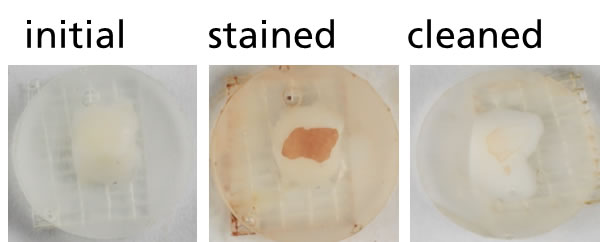Fraunhofer IMWS tests environmentally friendly microplastic alternatives in cosmetic products

Photographic images of tooth enamel samples in their initial state, after discoloration and after cleaning. The samples were cleaned with a toothpaste containing cellulose. Fraunhofer IMWS
Many cosmetic products such as body peelings or deodorants contain tiny plastic particles, so-called microplastics, for example made of polyethylene (PE) and polypropylene (PP). As “gentle abrasives”, they remove dead skin flakes by means of friction and stimulate the blood circulation of the skin.
Due to their chemical resistance and their lack of color, smell and taste, they are also frequently used as stabilizers and fillers. Polyethylene and polypropylene are non-biodegradable and due to the small particle size of less than 5 millimeters, the microplastic that has been introduced into waste water with cosmetics cannot be sufficiently removed in sewage treatment plants.
It therefore reaches the environment and enters our waters. In the sea, microplastic particles are absorbed by living organisms and eventually enter our food chain. Many cosmetics manufacturers have therefore announced that they will abandon the use of microplastics and instead use suitable alternatives in the future.
With the recently completed research project “KosLigCel” within the framework of the leading-edge cluster BioEconomy, the Fraunhofer Institute for Microstructure of Materials and Systems IMWS is making a contribution to this. In the project, which is funded by the Federal Ministry of Education and Research, alternatives made of biodegradable materials were successfully developed and tested together with CFF GmbH, a cellulose processor from Gehren in Thuringia, and Skinomics GmbH from Halle (Saale), which is mainly responsible for galenic and dermatological examinations of products.
The goal was a cost-effective production of biodegradable cellulose particles from beech wood, oats, wheat and maize that meet the requirements for abrasiveness and cleaning performance in dental and skincare products. Specifically, alternatives for body peelings and toothpastes were tested. The particular challenge was to design the cellulose particles in such a way that their size, shape, hardness and surface structure lead to the desired product properties. Cellulose made of beech wood was specially modified and the optimization process was accompanied by microstructure analysis at Fraunhofer IMWS.
“After two years of research work with the project partners, we have achieved very good results: a test toothpaste with the optimized beech wood cellulose particles is characterized by a low abrasion effect, but nevertheless good cleaning performance,” says Dr. Sandra Sarembe, project coordinator at Fraunhofer IMWS. The biodegradable particles in toothpaste are used for the mechanical removal of bacterial plaque, tooth discoloration and food residues, but they may not damage tooth enamel.
“In the material characterization of several cellulose types, we have consistently collected positive data. This also applies to the use of these substances in wash peelings and other skin cosmetics,” Sarembe continues. The research team was able to scientifically confirm that cellulose particles have comparable effects in cosmetic products as a substitute for polyethylene. They are also biodegradable in water and can be produced at low cost. Cellulose particles can also be used as a filler in aluminum-free deodorants.
“The use of cellulose as biobased fillers could also be possible in other fields of application such as medical products. In addition, different cellulose types can be mixed, which promises a wide range of applications. Therefore, the particles have a high potential for new product developments and attractive marketing opportunities for sustainable or even vegan products,” says Dr. Andreas Kiesow, project manager at Fraunhofer IMWS.
The results obtained can also be used in the future for development in other cosmetic areas such as decorative cosmetics for mascara, powder or lipstick.
https://www.imws.fraunhofer.de/en/presse/pressemitteilungen/imws-umweltfreundlic…
Media Contact
All latest news from the category: Materials Sciences
Materials management deals with the research, development, manufacturing and processing of raw and industrial materials. Key aspects here are biological and medical issues, which play an increasingly important role in this field.
innovations-report offers in-depth articles related to the development and application of materials and the structure and properties of new materials.
Newest articles

First-of-its-kind study uses remote sensing to monitor plastic debris in rivers and lakes
Remote sensing creates a cost-effective solution to monitoring plastic pollution. A first-of-its-kind study from researchers at the University of Minnesota Twin Cities shows how remote sensing can help monitor and…

Laser-based artificial neuron mimics nerve cell functions at lightning speed
With a processing speed a billion times faster than nature, chip-based laser neuron could help advance AI tasks such as pattern recognition and sequence prediction. Researchers have developed a laser-based…

Optimising the processing of plastic waste
Just one look in the yellow bin reveals a colourful jumble of different types of plastic. However, the purer and more uniform plastic waste is, the easier it is to…



